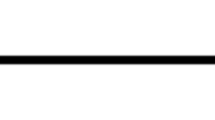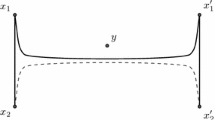Abstract
We build quasi-isometry invariants of relatively hyperbolic groups which detect the hyperbolic parts of the group; these are variations of the stable dimension constructions previously introduced by the authors.
We prove that, given any finite collection of finitely generated groups H each of which either has finite stable dimension or is non-relatively hyperbolic, there exist infinitely many quasi-isometry types of one-ended groups which are hyperbolic relative to H.
The groups are constructed using classical small cancellation theory over free products.
Similar content being viewed by others
References
E. Alibegović, A combination theorem for relatively hyperbolic groups, Bulletin of the London Mathematical Society 37 (2005), 459–466.
J. Behrstock, C. Druţu and L. Mosher, Thick metric spaces, relative hyperbolicity, and quasi-isometric rigidity, Mathematische Annalen 344 (2009), 543–595.
G. C. Bell and A. N. Dranishnikov, Asymptotic dimension, Topology and its Applications 155 (2008), 1265–1296.
G. C. Bell, A. N. Dranishnikov and J. E. Keesling, On a formula for the asymptotic dimension of free products, Fundamenta Mathematicae 183 (2004), 39–45.
G. C. Bell and K. Fujiwara, The asymptotic dimension of a curve graph is finite, Journal of the London Mathematical Society 77 (2008), 33–50.
M. Bestvina, K. Bromberg and K. Fujiwara, Constructing group actions on quasitrees and applications to mapping class groups, Publications Mathématiques. Institut de Hautes Études Scientifiques 122 (2015), 1–64.
A. Borel and G. Harder, Existence of discrete cocompact subgroups of reductive groups over local fields, Journal für die Reine und Angewandte Mathematik 298 (1978), 53–64.
B. H. Bowditch, Relatively hyperbolic groups, International Journal of Algebra and Computation 22 (2012), 1250016.
C. Champetier, Propriétés statistiques des groupes de présentation finie, Advances in Mathematics 116 (1995), 197–262.
M. Cordes and D. Hume, Stability and the Morse boundary, Journal of the London Mathematical Society 95 (2017), 963–988.
F. Dahmani, Combination of convergence groups, Geometry and Topology 7 (2003), 933–963.
F. Dahmani, V. Guirardel and P. Przytycki, Random groups do not split, Mathematische Annalen 349 (2011), 657–673.
C. Druţu and M. Sapir, Tree-graded spaces and asymptotic cones of groups, Topology 44 (2005), 959–1058.
C. Druţu, Relatively hyperbolic groups: geometry and quasi-isometric invariance, Commentarii Mathematici Helvetici 84 (2009), 503–546.
M. J. Dunwoody, The accessibility of finitely presented groups, Inventiones Mathematicae 81 (1985), 449–458.
M. G. Durham and S. J. Taylor, Convex cocompactness and stability in mapping class groups, Algebraic & Geometric Topology 15 (2015), 2839–2859.
B. Farb, Relatively hyperbolic groups, Geometric and Functional Analysis 8 (1998), 810–840.
B. W. Groff, Quasi-isometries, boundaries and JSJ-decompositions of relatively hyperbolic groups, Journal of Topology and Analysis 5 (2013), 451–475.
M. Gromov, Hyperbolic groups, in Essays in Group Theory, Mathematical Sciences Research Institute Publications, Vol. 8, Springer, New York, 1987, pp. 75–263.
D. Gruber, Personal communication.
D. Hume, Embedding mapping class groups into a finite product of trees, Groups, Geometry, and Dynamics 11 (2017), 613–647.
O. Kharlampovich and A. G. Myasnikov, Equations and fully residually free groups, in Combinatorial and Geometric Group Theory, Trens in Mathematics, Birkhäuser/Springer, Basel, 2010, pp. 203–242.
R. C. Lyndon and P. E. Schupp, Combinatorial Group Theory, Classics in Mathematics, Springer-Verlag, Berlin, 2001.
J. M. Mackay, Conformal dimension and random groups, Geometric and Functional Analysis 22 (2012), 213–239.
J. M. Mackay and A. Sisto, Embedding relatively hyperbolic groups in products of trees, Algebraic & Geometric Topology 13 (2013), 2261–2282.
D. V. Osin, Asymptotic dimension of relatively hyperbolic groups, International Mathematics Research Notices 35 (2005), 2143–2161.
D. V. Osin, Relatively hyperbolic groups: intrinsic geometry, algebraic properties, and algorithmic problems, Memoirs of the American Mathematical Society 179 (2006).
P. Papasoglu and K. Whyte, Quasi-isometries between groups with infinitely many ends, Commentarii Mathematici Helvetici 77 (2002), 133–144.
J. Roe, Hyperbolic groups have finite asymptotic dimension, Proceedings of the American Mathematical Society 133 (2005), 2489–2490.
R. Schwartz, The quasi-isometry classification of rank one lattices, Publications Mathématiques. Institut des Hautes Etudes Scientifiques 82 (1995), 133–168.
Z. Sela, Diophantine geometry over groups. I. Makanin–Razborov diagrams, Publications Mathématiques. Institut des Hautes Études Scientifiques 93 (2001), 31–105.
L. Silberman, Addendum to: “Random walk in random groups” [Geom. Funct. Anal. 13 (2003), no. 1, 73–146; MR1978492] by M. Gromov, Geometric and Functional Analysis 13 (2003), 147–177.
A. Sisto, Projections and relative hyperbolicity, L’Enseignement Mathématique 59 (2013), 165–181.
J. Stallings, Groups of dimension 1 are locally free, Bulletin of the American Mathematical Society 74 (1968), 361–364.
J. Stallings, Group Theory and Three-Dimensional Manifolds, Yale Mathematical Monographs, Vol. 4, Yale University Press, New Haven, CT, 1971.
R. Strebel, Appendix. Small cancellation groups, in Sur les groupes hyperboliques d’après Mikhael Gromov (Bern, 1988), Progress in Mathematics, Vol. 83, Birkhäuser Boston, Boston, MA, 1990, pp. 227–273.
Author information
Authors and Affiliations
Corresponding author
Rights and permissions
About this article
Cite this article
Cordes, M., Hume, D. Relatively hyperbolic groups with fixed peripherals. Isr. J. Math. 230, 443–470 (2019). https://doi.org/10.1007/s11856-019-1830-5
Received:
Revised:
Published:
Issue Date:
DOI: https://doi.org/10.1007/s11856-019-1830-5




